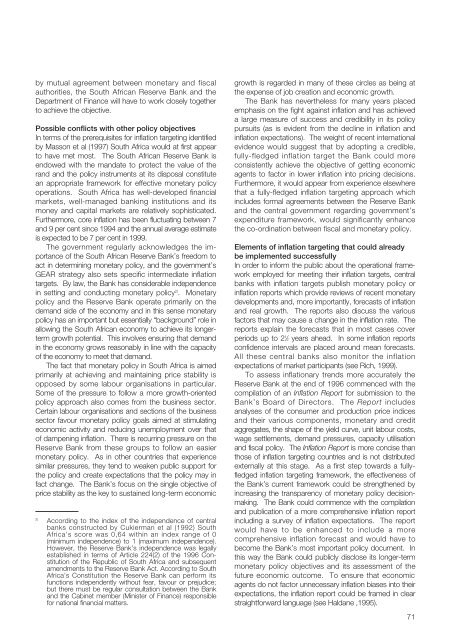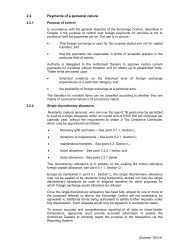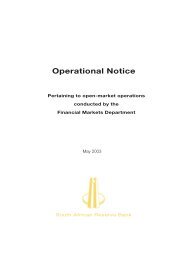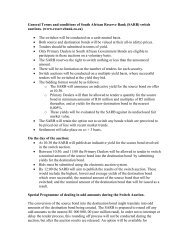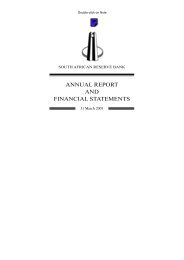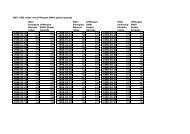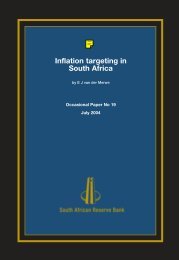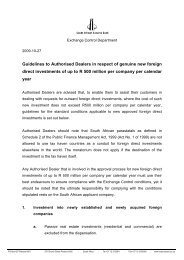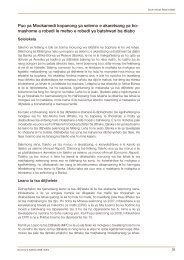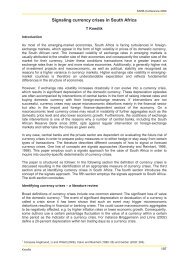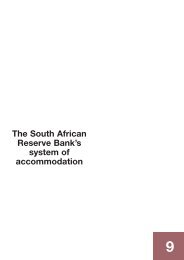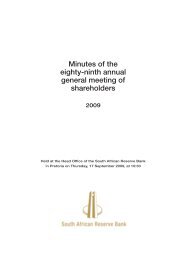Article: Quarterly Bulletin - South African Reserve Bank
Article: Quarterly Bulletin - South African Reserve Bank
Article: Quarterly Bulletin - South African Reserve Bank
You also want an ePaper? Increase the reach of your titles
YUMPU automatically turns print PDFs into web optimized ePapers that Google loves.
y mutual agreement between monetary and fiscal<br />
authorities, the <strong>South</strong> <strong>African</strong> <strong>Reserve</strong> <strong>Bank</strong> and the<br />
Department of Finance will have to work closely together<br />
to achieve the objective.<br />
Possible conflicts with other policy objectives<br />
In terms of the prerequisites for inflation targeting identified<br />
by Masson et al (1997) <strong>South</strong> Africa would at first appear<br />
to have met most. The <strong>South</strong> <strong>African</strong> <strong>Reserve</strong> <strong>Bank</strong> is<br />
endowed with the mandate to protect the value of the<br />
rand and the policy instruments at its disposal constitute<br />
an appropriate framework for effective monetary policy<br />
operations. <strong>South</strong> Africa has well-developed financial<br />
markets, well-managed banking institutions and its<br />
money and capital markets are relatively sophisticated.<br />
Furthermore, core inflation has been fluctuating between 7<br />
and 9 per cent since 1994 and the annual average estimate<br />
is expected to be 7 per cent in 1999.<br />
The government regularly acknowledges the importance<br />
of the <strong>South</strong> <strong>African</strong> <strong>Reserve</strong> <strong>Bank</strong>’s freedom to<br />
act in determining monetary policy, and the government’s<br />
GEAR strategy also sets specific intermediate inflation<br />
targets. By law, the <strong>Bank</strong> has considerable independence<br />
in setting and conducting monetary policy 2) . Monetary<br />
policy and the <strong>Reserve</strong> <strong>Bank</strong> operate primarily on the<br />
demand side of the economy and in this sense monetary<br />
policy has an important but essentially “background” role in<br />
allowing the <strong>South</strong> <strong>African</strong> economy to achieve its longerterm<br />
growth potential. This involves ensuring that demand<br />
in the economy grows reasonably in line with the capacity<br />
of the economy to meet that demand.<br />
The fact that monetary policy in <strong>South</strong> Africa is aimed<br />
primarily at achieving and maintaining price stability is<br />
opposed by some labour organisations in particular.<br />
Some of the pressure to follow a more growth-oriented<br />
policy approach also comes from the business sector.<br />
Certain labour organisations and sections of the business<br />
sector favour monetary policy goals aimed at stimulating<br />
economic activity and reducing unemployment over that<br />
of dampening inflation. There is recurring pressure on the<br />
<strong>Reserve</strong> <strong>Bank</strong> from these groups to follow an easier<br />
monetary policy. As in other countries that experience<br />
similar pressures, they tend to weaken public support for<br />
the policy and create expectations that the policy may in<br />
fact change. The <strong>Bank</strong>’s focus on the single objective of<br />
price stability as the key to sustained long-term economic<br />
2)<br />
According to the index of the independence of central<br />
banks constructed by Cukierman et al (1992) <strong>South</strong><br />
Africa’s score was 0,64 within an index range of 0<br />
(minimum independence) to 1 (maximum independence).<br />
However, the <strong>Reserve</strong> <strong>Bank</strong>’s independence was legally<br />
established in terms of <strong>Article</strong> 224(2) of the 1996 Constitution<br />
of the Republic of <strong>South</strong> Africa and subsequent<br />
amendments to the <strong>Reserve</strong> <strong>Bank</strong> Act. According to <strong>South</strong><br />
Africa’s Constitution the <strong>Reserve</strong> <strong>Bank</strong> can perform its<br />
functions independently without fear, favour or prejudice;<br />
but there must be regular consultation between the <strong>Bank</strong><br />
and the Cabinet member (Minister of Finance) responsible<br />
for national financial matters.<br />
growth is regarded in many of these circles as being at<br />
the expense of job creation and economic growth.<br />
The <strong>Bank</strong> has nevertheless for many years placed<br />
emphasis on the fight against inflation and has achieved<br />
a large measure of success and credibility in its policy<br />
pursuits (as is evident from the decline in inflation and<br />
inflation expectations). The weight of recent international<br />
evidence would suggest that by adopting a credible,<br />
fully-fledged inflation target the <strong>Bank</strong> could more<br />
consistently achieve the objective of getting economic<br />
agents to factor in lower inflation into pricing decisions.<br />
Furthermore, it would appear from experience elsewhere<br />
that a fully-fledged inflation targeting approach which<br />
includes formal agreements between the <strong>Reserve</strong> <strong>Bank</strong><br />
and the central government regarding government’s<br />
expenditure framework, would significantly enhance<br />
the co-ordination between fiscal and monetary policy.<br />
Elements of inflation targeting that could already<br />
be implemented successfully<br />
In order to inform the public about the operational framework<br />
employed for meeting their inflation targets, central<br />
banks with inflation targets publish monetary policy or<br />
inflation reports which provide reviews of recent monetary<br />
developments and, more importantly, forecasts of inflation<br />
and real growth. The reports also discuss the various<br />
factors that may cause a change in the inflation rate. The<br />
reports explain the forecasts that in most cases cover<br />
periods up to 2 1 ⁄2 years ahead. In some inflation reports<br />
confidence intervals are placed around mean forecasts.<br />
All these central banks also monitor the inflation<br />
expectations of market participants (see Rich, 1999).<br />
To assess inflationary trends more accurately the<br />
<strong>Reserve</strong> <strong>Bank</strong> at the end of 1996 commenced with the<br />
compilation of an Inflation Report for submission to the<br />
<strong>Bank</strong>’s Board of Directors. The Report includes<br />
analyses of the consumer and production price indices<br />
and their various components, monetary and credit<br />
aggregates, the shape of the yield curve, unit labour costs,<br />
wage settlements, demand pressures, capacity utilisation<br />
and fiscal policy. The Inflation Report is more concise than<br />
those of inflation targeting countries and is not distributed<br />
externally at this stage. As a first step towards a fullyfledged<br />
inflation targeting framework, the effectiveness of<br />
the <strong>Bank</strong>’s current framework could be strengthened by<br />
increasing the transparency of monetary policy decisionmaking.<br />
The <strong>Bank</strong> could commence with the compilation<br />
and publication of a more comprehensive inflation report<br />
including a survey of inflation expectations. The report<br />
would have to be enhanced to include a more<br />
comprehensive inflation forecast and would have to<br />
become the <strong>Bank</strong>’s most important policy document. In<br />
this way the <strong>Bank</strong> could publicly disclose its longer-term<br />
monetary policy objectives and its assessment of the<br />
future economic outcome. To ensure that economic<br />
agents do not factor unnecessary inflation biases into their<br />
expectations, the inflation report could be framed in clear<br />
straightforward language (see Haldane ,1995).<br />
71


